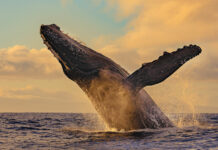Story and photos by Daniel Sullivan
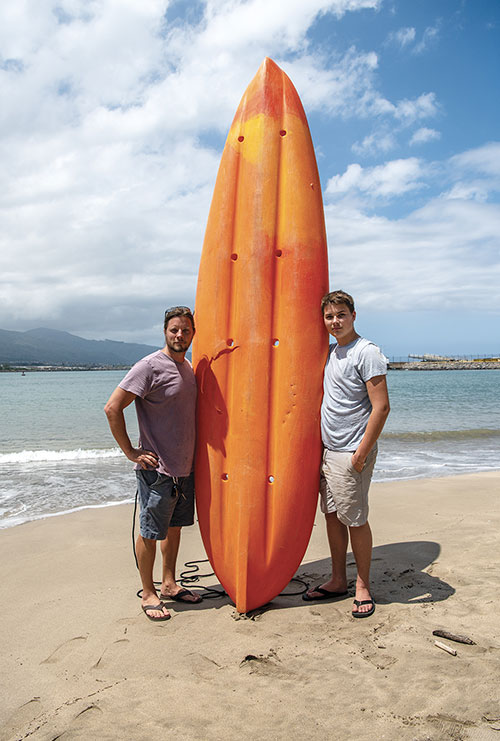
February 2nd, 2021, was the most perfect day. The seasonal island rains and winds had finally subsided and the forecast showed clear skies. The week prior, my teenage son, Tristan, and I had tied our old orange kayak to the top of our van in anticipation of a father-son whale-watching trip. Today was that day.
Our destination was Ukumehame beach just south of Olowalu along the West Maui coast. I put my camera (already in its waterproof housing), my phone and the car keys into a red dry bag and strapped it to the kayak. The waves were bigger than we’d expected, and we had wait, timing our launch correctly in between sets so as not to be flipped over. Finally, we got it right and paddled out over the reef, Tristan in the front of the boat and myself in the back.
We left the beach at 11:35 a.m. I know this because Tristan double-checked the time as we departed so we’d know how long it would take us to paddle back in.
The water was like glass, the perfect combination of aquamarine, emerald and turquoise. The reef below was a collection of dancing pastels, and brain-like coral heads peeked out of the water; it was low tide.
As we paddled toward the channel, the wind and waves picked up, blowing against us. Our strokes became a struggle.
“At least it will be easier getting back in,” I said. “The wind will be at our backs.”
We reached the channel — a deep, dark infinity. We stopped paddling and drifted, allowing the rolling waves to lift and lower us in synchronous rhythm. Sometimes, if you’re quiet and listen closely, you can hear the whales singing through your boat: the hollow shape of the kayak acts as a large speaker, amplifying their song.
There was a loud crack — the sound of a fin slapping the water. Several hundred yards off to the right, a whale tail rose up out of the ocean. Nearby, a baby whale also flipped up its tail, mimicking its mother. Two dolphins leapt and landed with a splash, as if ushering the whales through the channel, and a large escort whale brought up the rear.
So far, this day was already more than we could have hoped for.
“I think they’re coming toward us,” said Tristan. He was right.
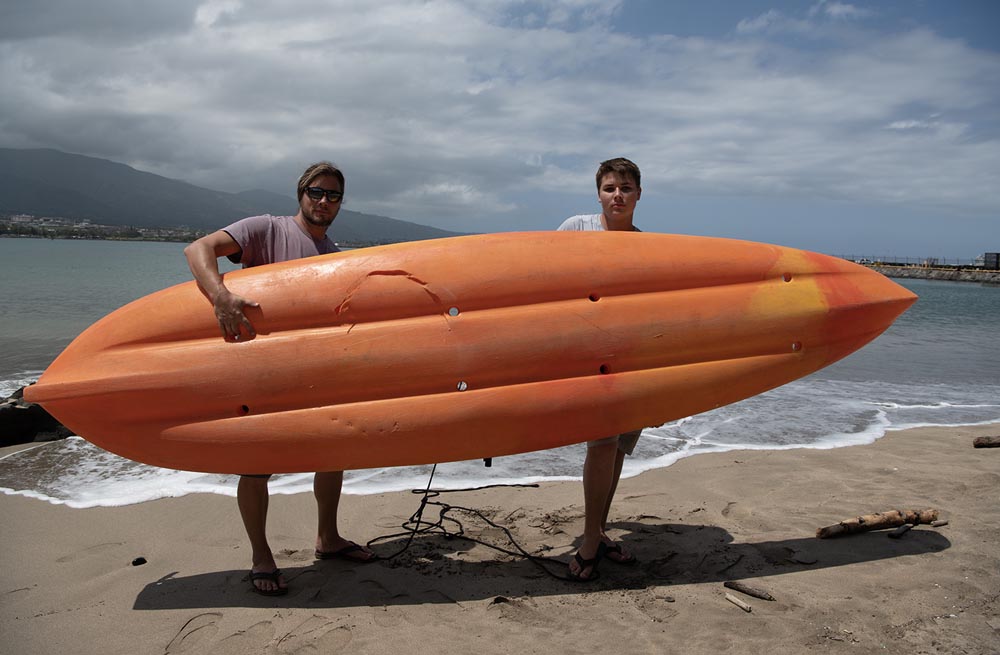
The waters around Hawai‘i are a protected federal marine sanctuary, and it is unlawful to purposely come within 200 yards of a whale. However, if the whales choose to approach you, the prevailing advice is to remain still and calm until they pass. This is called a “mugging,” when whales get curious and surround your boat. Sometimes they even lift their heads to have a good look at the strange surface-dwellers in their odd floating contraptions.
We were being mugged.
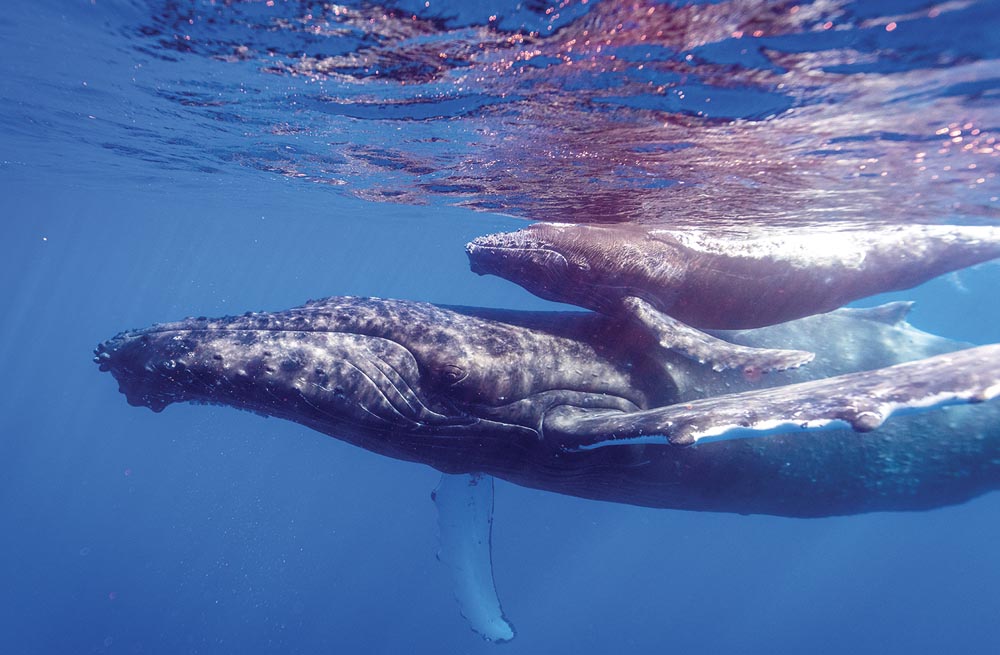
As the whales approached our kayak, I was as nervous as I was excited. To have an adult humpback — the length of about three school buses lined up end-to-end — emerge alongside our 12-foot fiberglass kayak was humbling, to say the least.
The surreal pod surrounded us. Mother and calf swam right beside our boat. I pulled my camera out of the dry bag and slowly, quietly, slipped it into the water off the side of the kayak, taking several shots of them as they passed.
The calf flopped about in the waves, clumsy and awkward, like a toddler learning to take his first steps. Tristan and I smiled at each other, marveling at the sublime perfection of nature.
Suddenly, we were struck from the left, and as our boat shot up and out of the water, I saw something straight out of a horror movie: a pointed head with serrated teeth clamping down on the kayak just inches from my legs. It was a great white shark.
Everything went flying — fins, camera, bags — then the shark pulled the kayak down, dumping us into the water. I was still holding my paddle and as I struggled to get my bearings, the shark turned toward me; it was bigger than our kayak.
I had always been told that if you were attacked by a shark that you should punch it in the nose, which seemed an absurd idea, especially since I had never even punched a person. But now, fear and adrenaline took over and I exploded, hitting the shark again and again with the end of my paddle. It swung away from me and turned toward Tristan who was swimming to retrieve my camera. He would later tell me that, until that moment, he thought a whale had breached and knocked us over.
“Tristan, shark! Get in the boat! Shark!” I yelled.
He quickly swam back and we frantically worked to right the kayak. It was then that I saw the catastrophic, mouth-shaped bite. We scrambled back into the boat and lay down on the bottom, but the kayak was no longer buoyant. Water poured in through the shark-tooth holes and we began to sink.
“We’re going to have to swim for it,” I said.
“Let’s just call 911,” said Tristan. It was, of course, what we had always taught him. But we were much too far away from shore for anyone to arrive in time to rescue us. And the shark was still under our boat; I could hear its nose repeatedly hitting the bottom.
“We’re going to have to swim, baby,” I said to this young man. I hadn’t called him baby since he was four years old, riding on my shoulders.
Hearts in our throats, we got back into the water and swam away as fast as we could … but I was getting nowhere. The tow rope was wrapped around my leg, and as the kayak sank, it was also pulling me under. I dove underneath the water and quickly untied myself, all the while searching the infinite blue for anything shaped like a shark. I surfaced right next to my dry bag; I grabbed it.
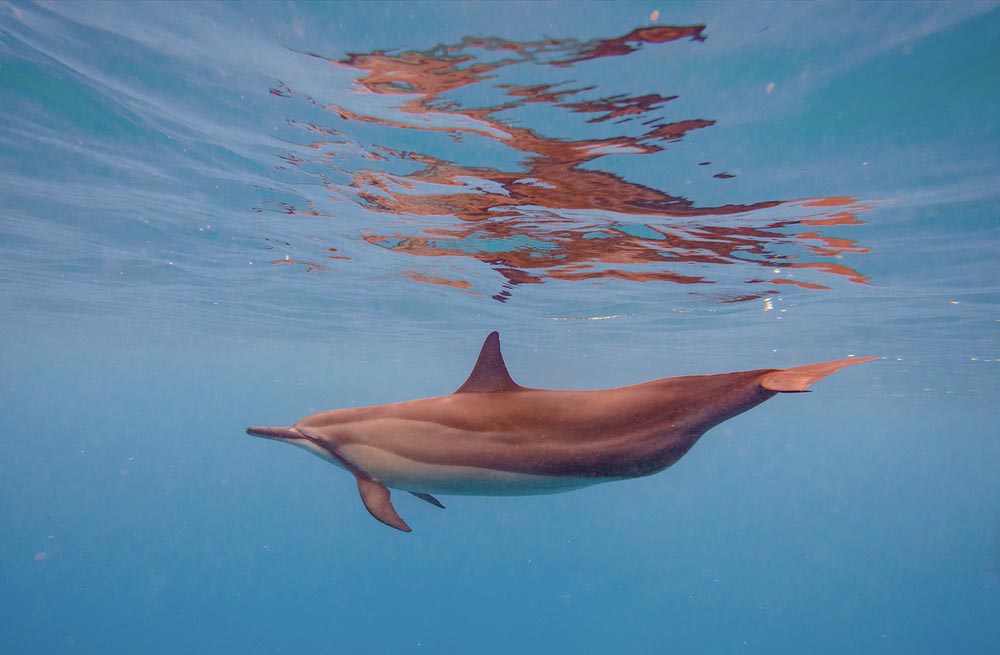
“Get out the phone! Call 911!” Tristan shouted.
I unrolled the bag and pulled out the phone. I tried to unlock it with my wet fingers. I tried to use face ID. I implored Siri to call 911, but she was unresponsive. All the while we were swimming, trying to put distance between ourselves and the shark. Waves pushed against us, and I couldn’t tell if we were making any progress. Exhaustion was already sinking in.
“Are we even moving?” Tristan asked, as if reading my thoughts.
I looked back at the sinking kayak; it was about 50 yards away.
“We’re good, we’re getting closer to shore,” I said, knowing very well that the beach was at least a mile away.
Tristan took the phone from me and tried in vain to activate it. But the screen turned white, and then faded to black as it died. He looked at me, distraught.
“We have to keep swimming,” I said. “Hold onto the other side of my camera and swim with me.” I knew the bulky plastic-and-glass housing could be used as a weapon if the shark returned.
“Just 10 strokes, then we’ll take a break,” I said. One, two three … I counted them off in my head. At the break I put my head underwater and stared into the abyss beneath. There was no sign of the shark, but that didn’t make me feel any better. I surfaced. My body was heavy, my energy and adrenaline spent from the attack. I felt like I might sink. Tristan swimming next to me was the only thing that was keeping me going.
“We’re not getting any closer,” Tristan said.
“Of course we are,” I said with what I hoped sounded like confidence. “Just a little further. We can do this.”
Then we heard a boat.
“Help!” we yelled with everything we had.
A small, white fishing boat carrying three men appeared, skimming along close to where the kayak had been. It slowed and the three men peered at us.
“Help! Help!” we called, waving our arms. But instead of coming to our rescue, the boat took off.
Tristan cursed at them and ranted with more emotion than I’d seen from him in years. “Why didn’t they stop?” he asked.
“I don’t know, but we’ve got to keep swimming,” I replied. Ten strokes, rest. Ten strokes, rest. This was our mantra of survival for what seemed like an eternity.
During a break I looked down into the water again. This time, instead of seeing the boundless blue of fear and uncertainty, I saw the bright white, green and gold of the reef. I popped up and looked ahead of us. In the distance, a line of cars raced along the highway. I noticed that the water was also warmer, and I felt … hope.
With new energy we swam toward shore. Our feet hit bottom and we climbed over the rocks, gasping. We sat next to each other, catching our breath, slowing our heart rates and taking stock of what had just happened.
“We’re alive,” I said. I grasped Tristan’s shoulder. He looked at me, exhausted and in shock. At that moment, I realized that he was a man. His childhood was behind him now forever, and this young man had handled this singular, brutal coming-of-age experience with utter courage. My chest ached with love and respect for my son, my survivor, and together we watched the waves gently lap the shore, as if trying to smooth away the raw edges of our experience.
What Are the Chances?
The Sullivans’ encounter with a great white shark is indeed the thing of nightmares, and nothing about their experience should be minimized, downplayed or taken lightly.
That being said, shark attacks are extremely rare.
“The number of shark attacks in Hawai‘i is very low, and most of the attacks that do occur are not fatal,” says Kim Holland, Ph.D., research professor at The Shark Lab at the Hawai‘i Institute of Marine Biology in O‘ahu.
Statistically speaking, your chance of being attacked by a shark is about 1 in 11.5 million, and your chance of actually being killed by a shark is 1 in 264 million, according to the Florida Museum of Natural History. For comparison’s sake, you have a 1 in 127 chance of dying from tripping, slipping or falling down, according to the National Safety Council; the odds of being killed in a car crash is 1 in 114; and your chance of dying from a gunshot is 1 in 6,905, according to the Florida Museum of Natural History. Though the odds are against it, attacks do happen and there are a number of ways you can prevent a terrifying encounter.
“The best thing you can do is swim with a friend or in an area with a lot of people,” says Holland. “Most shark attacks are nonlethal, and fatalities are usually due to blood loss or shock. Getting help from others dramatically increases your chances of survival.”
Also, avoid swimming in areas where rivers empty into the sea. “Tiger sharks are responsible for most of the attacks in Hawai‘i, and when they get large, they begin to eat more carrion,” says Holland. “Dead fish and animals are often found at river mouths, especially after heavy rains or a flood event.”
Similarly, stay out of the ocean if the water is muddy or murky after a rain, because if you can’t see the shark, the shark can’t see you. “It’s partly spec-ulation, but in my experience, if you see a shark and the shark is aware that you see it, an attack is less likely,” says Holland. “Tiger sharks especially are cautious and check out their prey before committing to an attack. If they feel like they have been observed, they become more cautious and are even less likely to attack.”
Common sense dictates that you shouldn’t swim around fishing boats or harbors, but other safety tips that seem sensible, such as staying out of the water if you have a small cut or if you’re menstruating, are mostly a byproduct of paranoia.
“Sharks do have an incredible sense of smell, but they are not super animals and can’t hone in on a cut on your
foot and track you down from miles away,” says Holland. “There is no situation where that could happen, especially in energetic waters like we have around Hawai‘i.”
It is also important to remember that we are visitors in an oceanic kingdom where sharks rule the reef. These apex predators play a crucial role in maintaining balance in the marine ecosystem, and though movies would have you believe otherwise, sharks don’t purposefully hunt you down; they are simply going about the business of being a shark when they come across a human being swimming on their turf.
Unfortunately, widespread fear of sharks and media sensationalism have vilified these essential creatures. According to the Shark Trust — a nonprofit whose mission is to safeguard sharks — human activities such as overfishing (which can result in shark bycatch) and the illegal practice of finning (slicing off a shark’s fins for soup and discarding the still-living shark to die), is pushing many species to the precipice of extinction.
So yes, be aware of yourself and your surroundings when you’re in the ocean, but don’t let fear get the best of you. Because if there’s anything you should take away here, it’s that your chances of having a shark encounter such as the Sullivans’ is extremely rare.
“Millions of people swim in Hawaiian waters every year,” says Holland. “The amazing thing is not how many shark attacks there are in Hawai‘i, it’s how few attacks there are.

